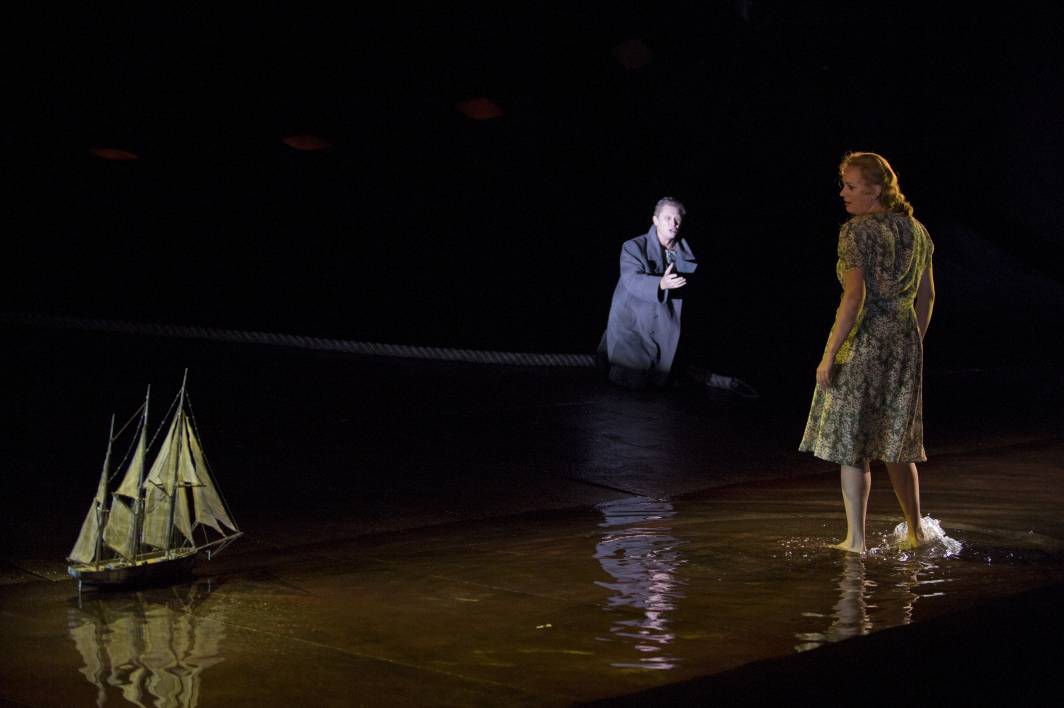Whether or not we believe Wagner’s retrospective rebranding of the opera as a prototype music-drama, “a complete, unbroken web”, Der Fliegende Holländer reliably makes for a vivid evening’s entertainment. Which makes it all the more strange that this is only the work’s third outing at the Royal Opera in almost 20 years. Animated by the push-pull of contrary rhythms and the slapping, spitting bite of the brass, Wagner’s compact score is almost overburdened by its drama, something understood by Tim Albery’s quietly effective production which sees the work undergo something of a sea change.
Greeted favourably when it debuted in 2009, the production relocates the folk tale of the arrogant mariner, forever condemned to wander the oceans unless he can be redeemed by the true love of a woman, to a non-specific contemporary setting. While a beautiful three-masted ship is present on stage, this model is dwarfed by the contemporary abstraction of a vessel that designer Michael Levine creates, its sweeping metallic curves by turns cradling the fragile action and then rearing up to hurl the Dutchman and his doomed Senta to their separate fates.
The psychological authenticity of the crazed fantasist Kampe creates in Senta comes at a vocal priceWe open, however, with one of Albery’s few missteps. The fretting exposed strings and horn cries that announce the Overture summon movement from the gauze curtain shielding the stage. For its full 10 minutes, and through the music’s many mood swings, the storm rages on in the curtain, accompanied eventually on a too-swift rotation by a searchlight that rakes blindingly over the audience. The 20th-century equivalent of those 18th-century operatic wave machines, this filler of a gesture is unworthy of what follows, distracting from Wagner’s score while adding little by way of drama.
The 2009 staging marked the return of Bryn Terfel to Wagner after his withdrawal from the Ring, his tormented, impassioned Dutchman central to Albery’s vision. While his Senta (Anja Kampe) returns for this revival, Terfel’s ghostly waders are here filled by the Latvian Egils Silins, a late replacement for Falck Struckmann. While his “Die frist ist um” didn’t quite find the bleak place it needed, interiorising the burden Albery heaps visually on him in the coil of rope that weighs python-like around his shoulders, he nevertheless found the tragedy that the composer recognised among the ironies of Heine’s satirical tale. His inability to unbend either physically or emotionally (aided in its stylised stiffness by David Finn’s Gothic lighting) gained pathos in the love duet, where Albery’s direction freezes the Dutchman and Senta to their separate spaces even as Wagner warms the music to boiling point.
 While some will be delighted by Kampe (pictured right with Silins), by her fearless attack of the extreme singing this role requires, the psychological authenticity of the crazed fantasist she creates in Senta comes at a vocal price. We see (and hear) the big fences coming, and while truth demands that she hurl herself at them with little care for beauty, at times the effect often crosses the line between artful disarray and actual lack of control. Her Ballad remains beautifully judged, a disquieting foil to the spinning song (wittily translated to a Western European garment factory).
While some will be delighted by Kampe (pictured right with Silins), by her fearless attack of the extreme singing this role requires, the psychological authenticity of the crazed fantasist she creates in Senta comes at a vocal price. We see (and hear) the big fences coming, and while truth demands that she hurl herself at them with little care for beauty, at times the effect often crosses the line between artful disarray and actual lack of control. Her Ballad remains beautifully judged, a disquieting foil to the spinning song (wittily translated to a Western European garment factory).
Also returning is John Tessier’s Steersman, whose legato makes a jewel of his love song, glittering like the Dutchman’s treasures against the matter-of-fact Daland (a rather under-characterised Stephen Milling). Endrik Wottrich makes an equally unremarkable job of Erik, his voice giving way in rather spectacular style under the weight of his closing confrontation with Senta, but his tensions were merely the most magnified of the evening’s singing as a whole.
The ensemble shuddered like Wagner’s stormy ocean, with Silins and the otherwise strong male chorus among the most at odds with the orchestra. Jeffrey Tate, striving for the more deliberate control and pacing that would make sense of the Dresden ending, found a no-place in his tempi that lacked either poise or real direction, creating unsightly tears in the musical cloth. Doubtless it will all settle, but with the complexities (and often noise) of Levine’s set still not fully worked out either, the effect was scrappy and distracting.
Issues of execution aside, Albery’s production remains a strong one, its muted simplicity daring to make something “rich and strange” out of Wagner’s awkward drama. This isn’t quite the impassioned love story Der Fliegende Holländer sometimes can be (and many will take issue with the ending), but in its place we get a meditation on human isolation and yearning that runs altogether deeper.
- Der Fliegende Holländer is at the Royal Opera House until 4 November















Add comment